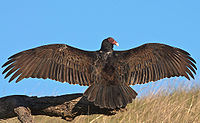Turkey Vulture
 From Conservapedia
From Conservapedia | Turkey Vulture | |
|---|---|

| |
| Scientific classification | |
| Kingdom Information | |
| Domain | Eukaryota |
| Kingdom | Animalia |
| Subkingdom | Bilateria |
| Phylum Information | |
| Phylum | Chordata |
| Sub-phylum | Vertebrata |
| Infraphylum | Gnathostomata |
| Class Information | |
| Superclass | Tetrapoda |
| Class | Aves |
| Sub-class | Neornithes |
| Order Information | |
| Order | Cathartiformes |
| Family Information | |
| Family | Cathartidae |
| Sub-family | Cathartinae |
| Genus Information | |
| Genus | Cathartes |
| Species Information | |
| Species | C. aura |
| Population statistics | |
| Conservation status | Least concern[1] |
Turkey vulture (Cathartes aura), the most abundant and widespread New World vulture.
Description[edit]
Turkey vultures are eagle-sized. They are 25-32 inches in length, with a wingspan up to 72 inches. The plumage is primarily blackish-brown in color and shiny on the back, with both primary and secondary flight feathers a paler color; in flight turkey vultures hold their wings in a shallow "V" dihedral angle, making identification easier when seen in company with other vultures. The subspecies C. a. ruficollis is darker, has a yellowish neck and apex, and the margins of the wing-wings are less pronounced. With C. a. jota the margins of the wings are distinctly gray. The naked head is red in color, and when sitting at a short distance the similarity to the wild turkey is what gave this vulture its name. Immature birds have a grey head.
Subspecies[edit]
- Cathartes aura aura; Mexico and the Greater Antilles to South America.
- Cathartes aura jota; Chile.
- Cathartes aura meridionalis; North America: southern Canada west of Great Lakes to British Columbia, south to Mexico (Baja California) and the southwestern United States. Migrates to South America.
- Cathartes aura ruficollis; Trindad; Panama to South America east of the Andes Mountains, south to Argentina and the Falkland Islands.
- Cathartes aura septentrionalis; eastern North America: United States and Canada.
Habitat[edit]
Primarily attached to deciduous woodlands and forests, yet often seen over nearby farmland and suburban areas.
Diet[edit]
Turkey vultures search for carrion individually or in small groups, sliding or rocking on the thermals. Although capable of making actual kills (such as on small mammals and birds), they kill less than black vultures and are more dependent on carrion, which they locate primarily by scent. Often they are the first vulture in a fresh carcass, but when the site is dominated by black and greater yellow-headed vultures they wait, and later eat the remains left behind by them.
In human populated areas they often eat dead animals on road sides; this source of food has probably allowed the birds to expand their range further north.
Reproduction[edit]
The reproductive biology of North American turkey vultures has been well studied. Eggs are laid in Florida in March, in the rest of North America from May to June, in Cuba from December to March and in Panama from February to April. The two eggs are placed directly on the ground in caves, on cliff promontories or between rocks and then incubated for 38 to 41 days; no nest is built. The chicks are covered in white down when hatched, and fledge after 70 to 80 days.
Value to man[edit]
Turkey vultures, though widespread and considered harmless to humans, have once been viewed as pests; i.e. there was a belief that the birds killed livestock, although these animals were in fact already dead when the first birds arrived, the turkey vulture being incapable of killing an animal larger than a rat. This attitude has changed over the years, and the bird is actually being used by man for different purposes. Police departments have experimented with turkey vultures in order to find out if they can locate human corpses, with mixed results[2][3]. Oil companies have had better luck: by adding ethyl mercaptan (a chemical also found in carrion) to the oil in pipelines, they can utilize the birds to detect leaks in the pipelines[4][5].
References[edit]
- ↑ http://www.iucnredlist.org/details/22697627/0
- ↑ http://www.thenational.ae/news/world/europe/police-train-vultures-to-find-human-remains
- ↑ https://www.bbc.com/news/world-europe-13956581
- ↑ http://www.popsci.com/gas-leaks-are-designed-to-attract-turkey-vultures
- ↑ https://www.allaboutbirds.org/do-vultures-find-dead-animals-by-smell-or-by-tracking-predators-or-scavengers-on-the-ground/
Categories: [Birds] [Birds of Prey] [Vultures]
↧ Download as ZWI file | Last modified: 03/03/2023 06:14:07 | 19 views
☰ Source: https://www.conservapedia.com/Turkey_vulture | License: CC BY-SA 3.0
 ZWI signed:
ZWI signed: KSF
KSF